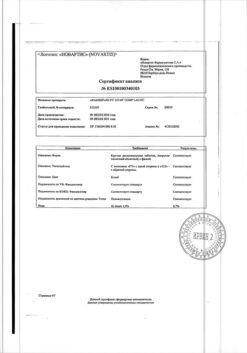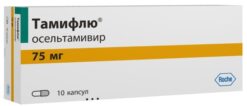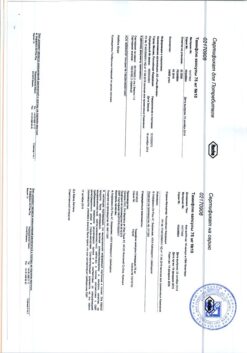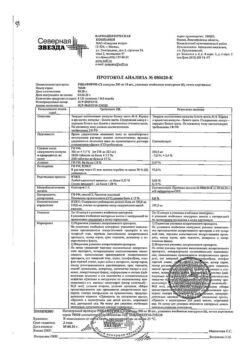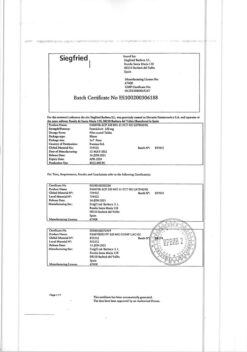No products in the cart.
Description
Genital itching and dryness, Cytomegalovirus infection, Skin itching, Herpes
Adults and adolescents aged 12 to 18 years
.p> – Treatment of infections of the skin and mucous membranes caused by HPV, including newly diagnosed and recurrent genital herpes (Herpes genitalis), and labial herpes (Herpes labialis);
– prevention (suppression) of recurrent infections of the skin and mucous membranes caused by HPV, including genital herpes, including in adults with immunodeficiency;
– prevention of infections caused by cytomegalovirus (CMV) and diseases after parenchymal organ transplantation.
Adults
– Treatment of herpes zoster (Herpes zoster) and ophthalmic herpes zoster.
Indications
Indications
Adults and teenagers aged 12 to 18 years
– treatment of infections of the skin and mucous membranes caused by HSV, including newly diagnosed and recurrent genital herpes (Herpes genitalis), as well as labial herpes (Herpes labialis);
– prevention (suppression) of recurrent infections of the skin and mucous membranes caused by HSV, including genital herpes, including in adults with immunodeficiency;
— prevention of infections caused by cytomegalovirus (CMV) and diseases after solid organ transplantation.
Adults
– treatment of herpes zoster (Herpes zoster) and ophthalmic herpes zoster.
Pharmacological effect
Pharmacological effect
Pharmacotherapeutic group: antiviral agent
Special instructions
Special instructions
Hydration
In patients at risk of dehydration, especially in elderly patients, it is necessary to ensure adequate water and electrolyte balance.
Use in patients with impaired renal function and in elderly patients
Since acyclovir is excreted by the kidneys, it is necessary to reduce the dose of Valvir in patients with impaired renal function. Elderly patients may experience impaired renal function, so dose reduction should be considered in this group of patients. Both elderly patients and patients with impaired renal function are at increased risk of developing neurological complications; such patients should be provided with careful medical supervision. As a rule, these reactions are mostly reversible if the drug is discontinued.
Treatment of labial herpes and prevention of CMV infections and diseases
The use of high doses of the drug Valvir for liver dysfunction and after liver transplantation. There is no data on the use of Valvir in high doses (4000 mg per day or higher) in patients with liver disease, so high doses of Valvir should be administered to such patients with caution. No special studies have been conducted to study the effect of Valvir in liver transplantation. However, it has been found that prophylactic administration of high doses of acyclovir reduces the manifestations of CMV infection and disease.
Use for genital herpes
Patients should be advised to abstain from sexual intercourse if symptoms are present, even if treatment with the antiviral drug Valvir has already been started. Suppressive therapy with Valvir reduces the risk of transmission of genital herpes, but does not completely eliminate the risk of infection and does not lead to a complete cure. Therapy with Valvir is recommended in combination with reliable means of barrier contraception.
Drug reaction with eosinophilia and systemic manifestations (DRESS syndrome)
DRESS syndrome, which can be life-threatening or fatal, has been reported in association with treatment with valacyclovir. At the time the drug is prescribed, patients should be familiarized with the signs and symptoms of DRESS syndrome and skin reactions should be carefully monitored. If signs and symptoms suggestive of DRESS syndrome occur, discontinue valacyclovir immediately and consider alternative treatment if appropriate. If a patient develops DRESS syndrome while taking valacyclovir, re-prescribing valacyclovir to this patient in the future is unacceptable.
Use in pediatrics
There is no experience of clinical use of the drug in children under 12 years of age.
Impact on the ability to drive vehicles and machinery
Active ingredient
Active ingredient
Valaciclovir
Composition
Composition
1 tablet contains:
active ingredient: valacyclovir hydrochloride hydrate 611.70 mg or 1223.40 mg, corresponding to valacyclovir 500 mg or 1000 mg;
excipients: microcrystalline cellulose 59.60/119.20 mg, povidone-K30 24.50/49.00 mg, magnesium stearate 4.20/8.40 mg;
film coating: Opadry white Y-5-7068 (hypromellose 3cP 7.35/14.70 mg, hyprolose 6.30/12.60 mg, titanium dioxide 4.20/8.40 mg, macrogol/PEG 400 2.10/4.20 mg, hypromellose 50cP 1.05/2.10 mg) – 21.00/42.00 mg.
Pregnancy
Pregnancy
Fertility
In animal studies, valacyclovir had no effect on fertility. However, high doses of parenteral acyclovir have been associated with testicular effects in rats and dogs.
No studies have been conducted on the effects of valacyclovir on fertility in humans. However, no changes in sperm count, motility or morphology were observed in 20 patients after 6 months of daily use of valacyclovir in doses ranging from 400 mg to 1000 mg.
Pregnancy
There are limited data on the use of Valvir during pregnancy. The drug should be used during pregnancy only if the potential benefit to the mother outweighs the potential risk to the fetus.
Pregnancy registries documented pregnancy outcomes in women taking the drug valacyclovir or other drugs containing acyclovir (acyclovir is the active metabolite of valacyclovir), 111 and 1246 cases, respectively (of which 29 and 756 took the drugs in the first trimester of pregnancy), were pregnancy outcomes recorded prospectively. Analysis of data from the registry of pregnant women exposed to acyclovir did not reveal an increase in the number of birth defects in their children compared with the general population, and no specificity or pattern was found for any of the malformations that would indicate a common cause. Since the registry of pregnant women included a small number of women who took valacyclovir during pregnancy, reliable and definite conclusions about the safety of valacyclovir during pregnancy cannot be made.
Breastfeeding period
Acyclovir, the main metabolite of valacyclovir, passes into breast milk. After taking valacyclovir at a dose of 500 mg orally, Cmax in breast milk was 0.5-2.3 times (on average 1.4 times) higher than the corresponding concentrations of acyclovir in maternal blood plasma. The ratio of acyclovir AUC values in breast milk to maternal serum AUC ranged from 1.4 to 2.6 (mean 2.2).
The mean concentration of acyclovir in breast milk was 2.24 μg/ml (9.95 μmol/L). When the mother takes valacyclovir at a dose of 500 mg 2 times a day, breastfed children are exposed to the same effects of acyclovir as when taken orally at a dose of about 0.61 mg/kg/day. The half-life of acyclovir from breast milk is the same as from blood plasma.
Valacyclovir unchanged was not detected in maternal plasma, breast milk or infant urine. Valaciclovir drugs should be prescribed with caution to women during breastfeeding. However, IV acyclovir is used to treat HSV in infants at a dose of 30 mg/kg/day.
Contraindications
Contraindications
– hypersensitivity to valacyclovir, acyclovir and any other component included in the drug;
– children up to 12 years of age;
– children under 18 years of age in the treatment of herpes zoster and ophthalmic herpes zoster.
With caution
In patients with renal failure; patients with clinically significant forms of HIV infection; while taking nephrotoxic drugs.
Side Effects
Side Effects
To assess frequency, the following criteria were used (according to the World Health Organization (WHO) classification): very common (> 1/10); often (≥ 1/100 and < 1/10); uncommon (≥ 1/1000 and < 1/100); rare (> 1/10000 and < 1/1000); very rare (< 1/10000), frequency unknown (the frequency of development cannot be determined from the available data).
Clinical trial data
Nervous system disorders: often – headache.
Gastrointestinal disorders: often – nausea.
Data from post-registration studies
Disorders of the blood and lymphatic system: very rarely – leukopenia, thrombocytopenia. Basically, leukopenia was observed in patients with reduced immunity.
Immune system disorders: very rarely – anaphylaxis.
Mental disorders: rarely – confusion, hallucinations, depression of consciousness; very rarely – agitation, psychotic symptoms.
Nervous system disorders: rarely – dizziness; very rarely – tremor, ataxia, dysarthria, convulsions, encephalopathy, coma.
The symptoms listed above are mostly reversible and are usually observed in patients with impaired renal function or other predisposing conditions. In adult organ transplant patients receiving high doses (8 g per day) of valacyclovir for the prevention of CMV infection, neurological reactions develop more often than when taking lower doses.
Disorders of the respiratory system, chest and mediastinal organs: infrequently – shortness of breath.
Gastrointestinal disorders: rarely – abdominal discomfort, vomiting, diarrhea.
Disorders of the liver and biliary tract: very rarely – reversible disturbances in liver function tests, which are sometimes regarded as manifestations of hepatitis.
Skin and subcutaneous tissue disorders: uncommon – rashes, including manifestations of photosensitivity; rarely – itching; very rarely – urticaria, angioedema; frequency unknown – drug reaction with eosinophilia and systemic manifestations (DRESS).
Renal and urinary tract disorders: uncommon – hematuria (often associated with other renal disorders); rarely – renal dysfunction; very rarely – acute renal failure, renal colic.
Renal colic may be associated with impaired renal function. Cases of precipitation of acyclovir crystals in the lumen of the renal tubules have been reported. It is necessary to maintain an adequate drinking regime during treatment.
Other: In patients with severe immunocompromise, especially in adult patients with advanced HIV infection, receiving high doses of valacyclovir (8 g daily) for a long period of time, cases of renal failure, microangiopathic hemolytic anemia and thrombocytopenia (sometimes in combination) have been observed. Similar complications were noted in patients with the same underlying and/or concomitant diseases, but not receiving valacyclovir.
Interaction
Interaction
Acyclovir is excreted by the kidneys, mainly unchanged through active renal secretion. The combined use of drugs with this elimination mechanism may lead to increased plasma concentrations of acyclovir.
After the administration of valacyclovir at a dose of 1000 mg and the drugs cimetidine and probenecid, which are eliminated in the same way, an increase in the AUC of acyclovir is observed and, thus, the renal clearance of acyclovir is reduced. However, due to the broad therapeutic index of acyclovir, no dosage adjustment of valacyclovir is required.
In the treatment of labial herpes, prevention and treatment of diseases caused by CMV, caution must be exercised in the case of simultaneous use of valacyclovir in higher doses (4000 mg per day or higher) and drugs that compete with acyclovir for the elimination route, since there is a potential threat of increasing the plasma concentration of one or both drugs or their metabolites. An increase in the AUC of acyclovir and the inactive metabolite mycophenolate mofetil (an immunosuppressant used in organ transplant patients) has been observed when these drugs are administered concomitantly.
Concomitant use of valacyclovir with nephrotoxic drugs, including aminoglycosides, organic platinum compounds, iodinated contrast agents, methotrexate, pentamidine, foscarnet, cyclosporine and tacrolimus, should be used with caution, especially in patients with impaired renal function, and requires regular monitoring of renal function.
Overdose
Overdose
Symptoms
Acute renal failure and neurological disorders, including confusion, hallucinations, agitation, depression and coma, as well as nausea and vomiting, have been observed in patients receiving doses of valacyclovir higher than recommended. Such conditions were more often observed in patients with impaired renal function and elderly patients who received repeated higher than recommended doses of valacyclovir due to non-compliance with the dosage regimen.
Treatment
Patients should be under close medical supervision. Hemodialysis significantly promotes the removal of acyclovir from the blood and can be considered the method of choice in the management of patients with an overdose of the drug Valvir.
Storage conditions
Storage conditions
Store at a temperature not exceeding 25 C.
Keep out of the reach of children!
Shelf life
Shelf life
2 years.
Manufacturer
Manufacturer
Balkanpharma – Dupnitsa AD, Bulgaria
Additional information
| Shelf life | 2 years. |
|---|---|
| Conditions of storage | Store at temperatures under 25 C. Keep out of reach of children! |
| Manufacturer | Balkanfarma – Dupnitsa AD, Bulgaria |
| Medication form | pills |
| Brand | Balkanfarma – Dupnitsa AD |
Related products
Buy Valvir, 500 mg 42 pcs with delivery to USA, UK, Europe and over 120 other countries.



